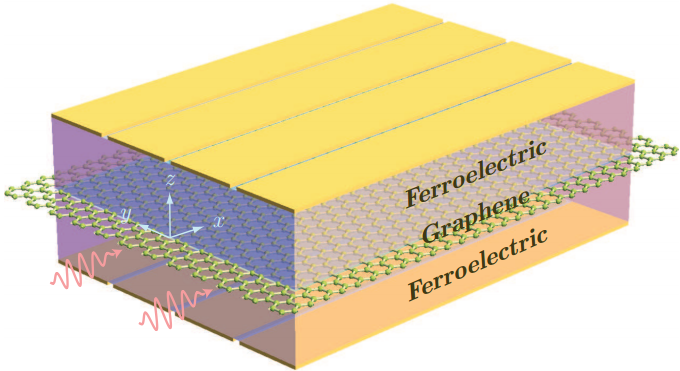Ferroelectric-graphene-based structure could lead to faster, smaller chips
June 24, 2013

Schematic of a ferroelectric-graphene-ferroelectric nanostructure (credit: Qing Hu)
MIT researchers have proposed a new system that combines ferroelectric materials — the kind often used for data storage — with graphene, a two-dimensional form of carbon known for its exceptional electronic and mechanical properties.
The resulting hybrid technology could eventually lead to computer and data-storage chips that pack more components in a given area and are faster and less power-hungry.
The new system works by controlling waves called surface plasmons (oscillations of electrons confined at interfaces between materials) In the new system, the plasmon waves in 2D graphene operate at ultra-high-speed terahertz frequencies (in between those of GHz chips and far-infrared light), which are considered ideal for next-generation computing devices.
The findings were reported in a paper in Applied Physics Letters by associate professor of mechanical engineering Nicholas Fang, postdoc Dafei Jin and three others.
Interconnecting light and electronics
The system would provide a new way to construct interconnected devices using light waves, such as fiber-optic cables and photonic chips. Currently, interconnection points often form a bottleneck that slows the transfer of data and adds to the number of components needed.
The team’s new system allows light waves to be concentrated at much smaller length scales, which could lead to a tenfold gain in the density of components that could be placed in a given area of a chip, Fang says.
The team’s initial proof-of-concept device uses a small piece of graphene sandwiched between two layers of ferroelectric material to make a simple, switchable plasmonic waveguide. They used lithium niobate for the , ferroelectric material, but many other such materials could be used, the researchers say.
Light can be confined in these waveguides down to one part in a few hundreds of the free-space wavelength, Jin says, which represents a tenfold improvement over any comparable waveguide system. “This opens up exciting areas for transmitting and processing optical signals,” he says.
Future ultra-high-speed disk drives
Moreover, the work may provide a new way to read and write electronic data into ferroelectric memory devices at very high speed, the MIT researchers say.
Dimitri Basov, a professor of physics at the University of California at San Diego who was not connected with this research, says the MIT team “proposed a very interesting plasmonic structure, suitable for operation in the technologically significant [terahertz] range. … I am confident that many research groups will try to implement these devices.”
Basov cautions, however, “The key issue, as in all of plasmonics, is losses. Losses need to be thoroughly explored and understood.”
The research was supported by the National Science Foundation and the Air Force Office of Scientific Research.